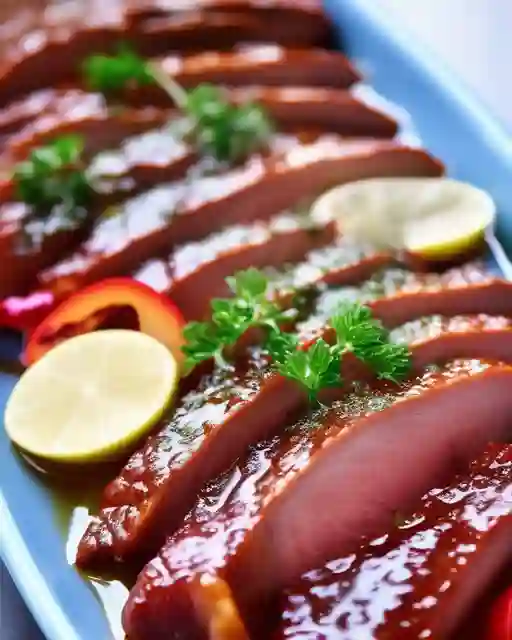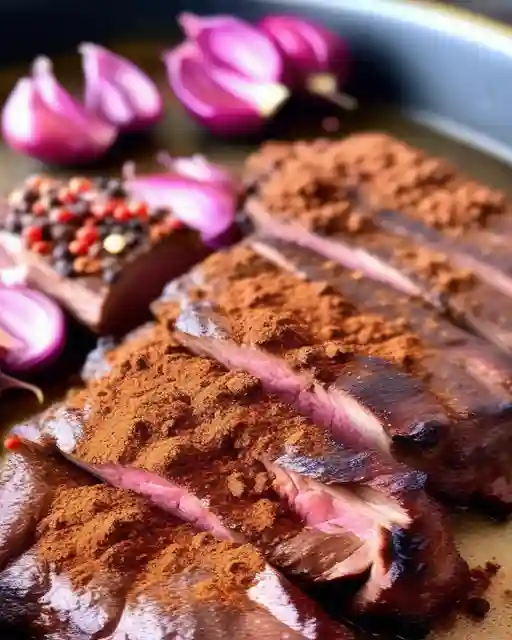Smokin’ Hot Meat Rubs Rating You Must Try This BBQ Season
Updated: 24 Jul 2023
176

Have you ever bitten into a juicy steak or tender chicken breast and wondered how it got that flavorful, textured crust coating each bite?
The secret is likely a flavorful meat rub! A meat rub is a mixture of spices, herbs, salt, pepper, and sometimes sugar that is generously hand-rubbed onto meat before cooking. The rub transforms ordinary meats into an explosion of flavors with delightful crusty exteriors when cooked to perfection.
Your tastebuds will go on a thrilling ride with the right rub! Finding and using meat rubs may need to be clarified for beginner home chefs. But have no fear! We will explain everything about evaluating and choosing the best store-bought or homemade meat rub to make your dishes sign. With a few helpful tips, you’ll be on your way to spicing up dinner times with tantalizing rubs in no time!
Table of Contents
What are Rubs?
Rubs are flavorful blends of spices, herbs, salt, pepper, and sometimes sugar that you rub onto meat before cooking. Rubbing these zesty mixes into meats helps form an incredibly tasty, textured crust when cooked.
What is Rub Rating?

Not all meat rubs are created equal when it comes to flavor. Some have the perfect blend of spices while others fall a little flat. That’s why it’s important to know how to evaluate rubs to determine which ones are truly top-tier.
Spicing Up Meat: Dry Rubs vs Wet Rubs vs Marinades
1. Dry Rubs

- Made of dry spice and herb mixtures
- Generally rubbed directly onto the meat’s surface
- Creates flavorful crust or bark when meat is cooked
- Very easy to make at home
2. Wet Rubs

- Made by mixing dry rubs with liquid ingredients like oil or lemon juice
- It can be brushed or spread onto the meat surface
- Provides moisture and allows rub to stick
- Often faster to absorb flavors than a marinade
3. Marinades

- Made by soaking meat fully submerged in liquid ingredients
- Can take hours for flavors to soak into the meat
- Tenderizes meats very well
- Works best for lean meats like chicken or pork
What’s Best?
Many people use dry rubs for quick and easy added flavor. Wet rubs also infuse taste fast. Marinades require more time but tenderize. Experiment to see if you like meat best with dry, wet, or soaked rub! The results will make your dishes finger lickin’ good!
What to Look for When Selecting Rub for Meat

1. Type of Meat
- Beef rubs – Bold, robust spices work best on hearty steaks or roasts
- Pork rubs – Sweet and spicy mixes complement the milder pork flavor
- Chicken/Turkey rubs – Savory or citrusy rubs pair nicely with white meats
- Lamb – Earthy herb and spice blends stand up to lamb’s strong flavor
2. Ingredients Matter
- Spices like garlic, pepper, chili powder add lots of flavor
- Herbs like rosemary, oregano, and thyme also taste great
- Sweet additions like brown sugar or honey balance stronger seasonings
- Don’t forget the salt and pepper to enhance overall taste
3. Flavor Profiles
- Sweet rubs with sugar or fruit make meat caramelize and taste yummy
- Smoky tastes come from paprika, cumin, chipotle chilies and more
- Spicy heat can come from cayenne, habanero, or jalapeño powders
- Herby flavors from rosemary, thyme, and other garden herbs
4. Coarse or Fine
- Coarse rubs have texture from spices or salts with bigger grains
- Finer powdered rubs spread evenly and penetrate meat well
5. Quality and Budget
- Organic or gourmet rubs offer premium quality at a higher cost
- Store brands or homemade cost less but may compromise on taste
- Read reviews to find value picks that combine quality and price
Finding the Tastiest Rubs for Your Meat
1. Check the Ingredient List
- See if quality herbs and spices are used
- Make sure salt or sugar aren’t too high up the list
- Look for flavors suited to the meat you’re cooking
2. Get the Flavor Combo
- See how ingredients like garlic, brown sugar, or heat combine
- Understand how spices complement each other
- Ensure the blend will give zest to your specific meat
3. Will It Give Good Texture?
- See if spices are the right size to help form a crust
- Check if the rub has texture components like seeds or citrus zest
- Determine if it will hold up on your grilling or smoking method
4. Read Reviews First
- Check Spice brand websites for reviews and ratings
- See what fellow cooks say about taste on forums and blogs
- This helps avoid bad rubs with no flavor or bad aftertaste
5. Do a Trial Run
- Test one or two new store-bought rubs at home first
- Apply to meat exactly as the package directs
- Get the family’s take on taste, aroma, texture
Top Meat Rubs to Try

1. All-Purpose and Bold Beef/Lamb Blends
- Great on juicy steaks or flavorful roasts
- often feature black pepper, rosemary, garlic
- Try Chicago Steak Rub or Montreal Meat Spices
2. Sweet and Savory Blends for Pork
- Maple bacon rubs are perfect for pork chops
- Chili-orange mixes are great on ham or tenderloin
- Whip up your own brown sugar and cumin rub
3. Citrus and Fruit Mixes for Poultry
- Lemon-pepper seasoning, yum on chicken breasts
- Sweet mango habanero on wings and drumsticks
- Tangy pineapple blends pair great with turkey
4. Unique Blends for Special Meals
- Impress guests with gourmet blends
- Truffles, juniper berries, or cardamom options
- Check specialty stores for exotic ingredient rubs
Be the star chef at your dinner table! With so many tasty store-bought or homemade rubs for all meats, why settle for flavorless? Dazzle family and friends with your kitchen creations!
Tips for Homemade Rubs
1. Start with the Basics
- Most rubs begin with salt, black pepper, and paprika
- Then build depth with garlic powder, chili powder, cumin
- Add brown sugar or honey for balanced sweetness
2. Mix and Match Flavors
- Try fun pairings like lemon and rosemary or orange and thyme
- Kick up the heat with cayenne, chipotle or jalapeño
- For sweeter blends stir in cinnamon, ginger, or nutmeg
3. Tailor Rubs to Each Meat
- Customize blends to match lighter meats like chicken or richer meats like beef
- Fruity flavors shine on poultry, herb mixes for lamb or pork
4. Make Small Batches
- Only mix as much dry rub as you’ll use in a few weeks
- Spices lose their potent aroma and flavors over time
- Tweak and improve mixes in each new batch
Unleash your inner chef with homemade rubs bursting with flavor! Ditch the boring old salt and pepper routine. wow family and friends by getting creative and crafting your own signature blends!
Scoring the Best Rubs Online or At Specialty Shops
1. Online Spice Stores
- Large selection of rubs at Amazon or speciality sites
- Look for ratings to identify top blends
- Order small batches first to taste test quality
2. Butcher Shops or Spice Stores
- Shop owners can recommend proven recipes
- Often have unique, handmade artisan blends
- Chat about customizing mixes you’ll love
3. Whip Up Your Own
- Quality ingredients key for fabulous DIY rubs
- Use our site’s recipes approved by chef testers
- Craft a signature family rub with fun themes
With the right homemade or gourmet store-bought rub, you’ll be on your way to fire-grilled, smoke-infused meat masterpieces in no time! Wow those taste buds and become the neighborhood’s best barbeque boss!
Storing and Applying Rubs
1. Keep Rubs Fresh
- Always store opened rubs in airtight containers away from light
- Heat and humidity shorten shelf life and make spices lose potency
- Keep containers in a cool, dark place like a cupboard
2. When to Rub It On
- Apply rub right before cooking for best flavor and texture
- If rubbed too early, spices can get soggy or overwhelm meat
3. Coating Coverage
- Generously coat all surfaces for caramelized crust on edges too
- Quick tip: Apply light coating first to help second coat stick better
4. Rest and Relax
- Once meat is thoroughly rubbed, let it sit 5-20 minutes
-Gives time for meat to absorb spices before cooking -Also brings meat closer to room temperature for more even cooking
Follow proper rub application guidelines and you’ll be rewarded with the most insanely delicious flavors!
Final Thoughts
Using the right meat rub can transform ordinary dishes into extraordinary culinary experiences. Seek out high quality blends with vibrant aromas and balanced, complex flavors. Consider spice styles and inclusions tailored to what you’ll be cooking. Beef lovers should reach for bold peppery blends while sweet or citrus mixes pair better with chicken or pork.
Consult rub ratings from us or fellow cooks rather than buying random jars off the shelf. Understand what sets gourmet recipes apart from so-so store brands. Consider making your own signature mixes as well using our guideline formulas focused on quality ingredients.
Apply rubs properly before cooking for ideal texture and flavor infusion too. Generously coat meat then let sit for spices to penetrate. The small effort of finding and using a top-tier rub makes all the difference in achieving backyard grill mastery. Your friends and family will be begging for your secret recipes in no time once they get a taste.
FAQs
How Do I Put Dry Rubs on Meat?
Start with clean, dry meat so spices stick well. Sprinkle a thin layer across the entire surface first. Then pat and press to help the coating adhere. Add a second, heavier coat and rub it in with your fingertips. Apply 45 minutes to 1 hour before cooking.
What Cooking Methods Work Best?
Dry rubs pair great with quick, hot cooking like grilling, broiling, pan searing. The high heat helps form an awesome browned, caramelized crust. Slow roasting or smoking lets spices fully penetrate for intense depth too.
Why the Salt in Rubs?
A small amount of salt enhances other flavors. It also helps draw out meat juices to better absorb the spice mix for well-balanced taste. No worries, using a rub won’t make your dish overly salty.
Should I Add Oil or Water?
Oil or water aren’t needed but can help rubs adhere if the meat surface is uneven. Many chefs recommend applying plain rub. Marinades have lots of moisture but take hours to penetrate meat.
Is Dry Rub Better Than Marinating?
It depends! Dry rubs infuse big flavor fast without needing to soak meat overnight. But marinades also tenderize along with infusing taste. Try dry rub for weeknight dinners, marinades for larger weekend cuts. Experiment to decide which you prefer best!
Please Write Your Comments